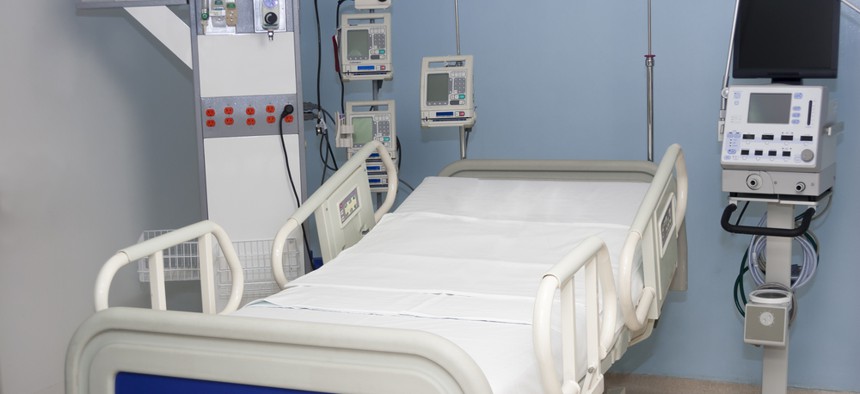What Quarantine In the U.S. Looks Like
American doctors may not be used to dealing with Ebola, but they are highly trained by the CDC to stop the spread of infectious disease.
In mid-August, a man who had recently traveled to Liberia showed up at an emergency room in Birmingham, Ala., with a fever.
Doctors quarantined the patient, fearing that he might have contracted Ebola, a deadly virus that has spread swiftly through West Africa in recent months.
Attending physicians at the University of Alabama-Birmingham hospital suited up, donning face masks, gloves, goggles, and full-body gowns. Meanwhile, the feverish patient was whisked away to an isolation room separate from the rest of the hospital.
Doctors eventually diagnosed the man with malaria. But the way the case was treated is similar—if not identical—to how hospitals would handle an Ebola outbreak if the virus begins to crop up across the U.S.
On Sunday, doctors diagnosed the first case of Ebola in a U.S. patient at the Texas Health Presbyterian Hospital of Dallas. The Centers for Disease Control and Prevention confirmed the diagnosis Tuesday.
For many Americans, it is a nightmare scenario. But while doctors in the U.S. may not be accustomed to treating Ebola, they are highly trained to deal with infectious disease. And, according to health officials, American hospitals are equipped to effectively quarantine Ebola patients.
Virtually every hospital in the country conforms to CDC guidelines designed to stop the spread of contagion. Doctors are taught to recognize the signs of infectious disease—ranging from meningitis to the Ebola virus—and quickly isolate anyone exhibiting symptoms.
Isolation rooms generally look like regular hospital rooms, complete with beds and television. Depending on the diagnosis, however, there are a few differences.
Patients with an airborne disease are placed in rooms with a ventilation system that keeps the air from migrating to the rest of the hospital. Rooms may also come equipped with an antechamber, where staff can suit up before entering. Typically, patients are asked to wear masks as well.
The most common illness that would land a patient in this type of isolation, known as a negative-airflow room, is tuberculosis.
Patients infected with a disease spread through bodily fluids, such as Ebola, are put in a different kind of quarantine, where the main precaution doctors take is to ensure they don't come into direct contact with the sick person.
In practice, this means that hospitals don't need high-tech equipment to handle an Ebola outbreak—just plenty of protective gear.
According to Mary Ann Codeglia, the administrative director of clinical quality at the San Ramon Regional Medical Center in California, gowns "come in all different colors, tie in the back and must be long enough to cover the arms and knees."
The type of apparel patients are outfitted with, Codeglia said, depends on the severity of the infection and how it is spread.
Patients are generally permitted to have visitors even while they are kept in isolation for an infectious disease. Family members can exit and enter the room as long as they wear the same protective clothing as hospital staff.
"An outbreak of ebola in the U.S. may seem scary, but there are standard precautions that health professionals take to deal with infection, and many of the same rules apply," said Dr. David Pigott, a member of the University of Alabama-Birmingham hospital's emergency response team.
The fairly routine response to contagion outlined by the CDC, however, is not what Ebola patients on U.S. soil encountered earlier this summer.
In August, two American aid workers who contracted the virus in West Africa were brought to Emory University Hospital in Atlanta. The patients were put into the hospital's highly specialized infectious-disease containment unit, one of only five such facilities in the U.S.
The unit is set up to treat diseases such as smallpox, the plague, and SARS. It comes equipped with an intercom system that visitors can use to communicate with patients without entering the room. Other features include a light-activated sink that turns on without being touched and easily accessible showers that doctors can use in the event of accidental contact with the patient.
Another American physician, Rick Sacra, was brought to a similar isolation ward in Omaha, Neb., in September after contracting Ebola in Liberia. Patients in the Omaha ward are transported on a gurney encased in a bubble-like seal.
Most American hospitals don't have those kinds of provisions. But health officials say they don't need to, and they stress that following CDC guidelines should be sufficient to prevent contagion.
The most effective way to strike back at the virus may also be the most old-fashioned and low-tech. "Diligent hand-washing is the most important part of preventing the spread of any infection," Codeglia said.
Dr. Sacra along with the two American aid workers brought to Atlanta in August have since recovered. A fourth American patient infected with Ebola abroad remains at Emory University hospital.
The World Health Organization estimates that there have been more than 6,500 reported cases of Ebola and more than 3,000 deaths since the current outbreak began in March.
(Image via herjua/Shutterstock.com)
NEXT STORY: Pump Up the Jams and Feel Powerful




